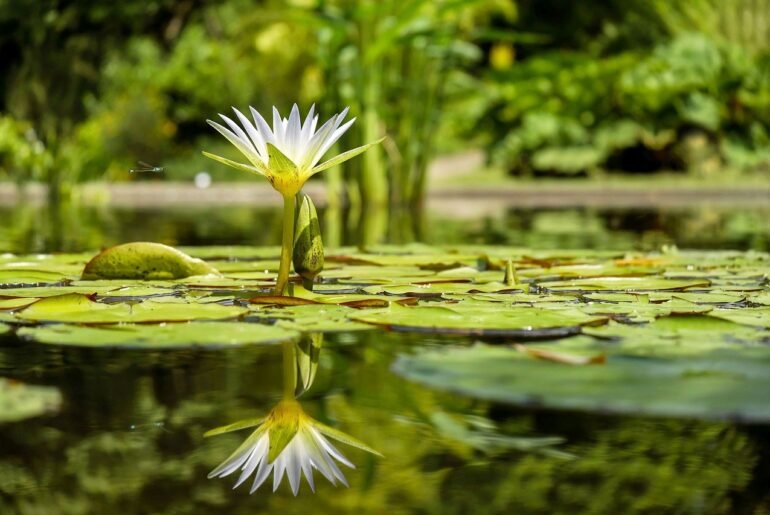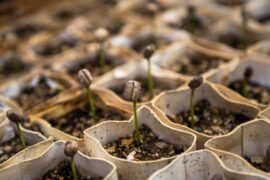When you think of a garden, the first thing that probably comes to mind is a rectangle full of vegetables or landscaped rose garden. Those who are willing to look beyond soil will be pleasantly surprised with a water garden option. Aquatic gardens are full of surprises, from the variety of plants to how they can be grown. By the time you are done reading, you will not only have an expansive knowledge of water garden plants, but you will be ready to get started with your own water garden.
What Are Water Plants?
Also known as aquatic plants, they have adapted to live in fresh or saltwater. To differentiate them from other aquatic flora like algae, they are also sometimes called hydrophytes or macrophytes. There are four distinct categories of water plants that are important to know when planning your garden or pond.
Floating
Unlike traditional plants that require soil, floating plants float freely. They have spongy bodies that fill with air and allow them to float on the water’s surface.
Fixed
Some plants look like they are floating on the surface, but they have long roots connected to soil in the pond. One of the most recognizable flowers in this category is water lilies and their lily pads.
Underwater
These plants are completely submerged and one hundred percent responsible for freaking you out by bushing against your leg in a lake. These plants are long with thin blades like giant grass, and they are rooted in soil under the water.
Marginal
Marginal flora like to grow at the edges of a pond or bog where the dirt is saturated. Mosses and creeping Jenny are a few examples of marginal options.
Most Common Plants for Water Garden
There are plenty of unique options available for your pond, each with distinct characteristics. Some are more popular than others due to their look, type, and ease of care. These are some of the more popular water plants that everyone seems to love.
Water Lillies
Water lilies are one of the most popular pond flowers because they are both beautiful and functional. These beautiful flowers come in several colors, and some tropical varieties even bloom at night with vibrant neon pink and blue colors. The lily pads that are so well known as frog beds also serve as shade for the water, which cuts down on the algae growth in your pond. Most beginners don’t understand that these are rooted plants and the most common way to get them in your pond is to plant them in a pot and sink the pot to the bottom of the pond.
Water Hyacinth
This is another popular pond plant for so many reasons, one of the most significant being how fast they grow. A few of these free-floating plants will cover your pond quickly, providing full coverage from the sun to slow algae bloom and protecting any underwater animals from predators. It is also not bad to look at with waxy green leaves and violet flowers. Be aware that its fast and exponential growth has earned it the mantle of being an invasive species in many southern states, so it is not legal to grow.
Water Lettuce
Despite its appetizing name, water lettuce is not something you would probably want to eat. It is a popular option in beginner ponds because it is relatively hardy and doesn’t take much care. It is free-floating, and you can place it right on the surface, and it will take it from there, even multiplying throughout the season. Water Lettuce gets its name because it looks like a head of lettuce, although water lettuce leaves have a fuzzy texture.
Frog Bit
Frogbit is another popular pond plant because it is free-floating and a smaller variety, making it great for indoor gardens. The frogbit’s leaf is tiny and kidney-shaped, surrounding a small white flower that blooms in the late summer. In nature, the frogbit provides coverage and protection for small fish, insect larvae, and tadpoles. Although frogbit floats on the water surface, it goes dormant in the winter, and the buds sink to the bottom to be buried in the soil.
Floating Water Moss
Floating water moss is one of the more unique plants featured because of its root system. It is not a moss at all but actually a three-leafed fern with a unique adaptation. While two leaves float above the water’s surface, a third leaf is submerged and acts as the plant root system absorbing nutrients. Many pond owners love this plant’s uniqueness; it is not very hardy and takes some extra care, like removing it from the pond in colder months if you don’t live in a particularly hot region.
Hornwort
Hornwort is a popular plant for outdoor ponds because it is incredibly hardy in most areas. It is a fully submerged free-floating plant, but some hobbyists like to tie them down to rocks in the pond to not float around and get caught in the filters. Fish love this underwater plant because it oxygenates the water and offers ample places to hide from predators. Since these plants don’t reproduce swiftly, they are one of the lowest maintenance pond plants you can buy.
Water Hibiscus
Water Hibiscus loves to grow in the shallows or saturated soil, so they are an excellent plant with which to line your water garden. The hibiscus has many benefits, including its hardiness, which allows it to lay dormant and return each spring even in regions where temperatures are well below freezing. The plant also blooms large, beautiful flowers, which are easy on the eyes and support local pollinators.
Water Mint
Water mint is a popular plant in container gardens because of its versatility. It is edible, just like traditional mint, but it is also fragrant and has gorgeous light purple flowers. They are happy growing in saturated soil or shallow waters and are surprisingly hardy surviving winters in subzero temps. Ensure that you have room for this plant to grow as it can reach heights of up to 3 feet tall.
Creeping Jenny
Creeping Jenny is a jack of all trades in both ponds and indoor gardens. It is usually used to fill the edges of a pond or garden and grows on almost any surface, including rocks and logs. They spread laterally and grow up to two inches tall; since they like to hang over the edges of your pond, they create a great transition into the water without taking up to much space for the plants that need more water to thrive.
Water Lotus
Water lotus is probably one of the most recognizable plants for water gardens and koi ponds. They are large, and the flowers are stunningly beautiful. Lotus plants are rooted in the soil and should be kept in a container if they are part of a koi pond to prevent the fish from digging up the roots. Lotus are surprisingly hardy and can survive winters in even northern Minnesota and Michigan.
What Do I Need for a Water Garden?
Creating container water gardens is a pretty straightforward endeavor even for novices, but you have to have the right tools for the job.
Container
The great thing about a container garden is that any container that will hold water and non-toxic will work for a container. They do make premade ponds and water garden containers that can be purchased. Although they would work, containers that are opaque or clear are not suggested because they amplify the sunlight and cause algae to proliferate. Glass containers can even cause a fire if the sun hits them in just the right way, much like a magnifying glass.
Water
You can’t have a water garden without water, but not all water is the same. Some fish and plants do better in certain water conditions, so if you are using tap water, make sure that it isn’t too hard or soft for your flora and fauna. Soft water can especially be detrimental to some plants because of the salt content.
Plants
Whether you go with a potted water lily or the easy-to-care-for frogbit, know what you are getting before setting up your pond.
Substrate
A container with floating and potted plants won’t need sand or soil, so that you can choose river rocks as a substrate. If you are going with fixed plants and don’t want to pot them, you will want a sand and soil mix on the bottom. This combination keeps the soil from floating to the top and helps to weigh down the roots.
Optional
Pump
You don’t need a pump for a container garden, but they have a lot of benefits. They keep the water cycling which keeps your pond cleaner and prevents mosquito larvae. People also find the sound of running water soothing. Many people hide the pump in water features, so it is just as much art as a function.
Fish
Fish are optional, but they play a symbiotic role in a container garden. Not only will fish eat mosquito larvae and other bugs out of pond water, but their poop fertilizes the plants.
Fertilizer
If you don’t want fish or do and think your plants need an extra boost, you can add some fertilizer specifically designed for aquatic plants.
How Do I Make it Look, Professional?
There are a few tricks that people of any skill level can do to make their pond look like it was professionally curated.
If you have an inground pond, you want it to look as natural as possible. You don’t want it to look like a hole in the ground, so it should have graded sides that gradually slope into the water with marginal plants like creeping jenny to create a transition into the water. The deepest part of the pond should reach at least 24 inches but would preferably be 36 inches or more to prevent the water from freezing all the way through.
If you are using a container garden and you don’t have a lot of room to do much but add plants in water, there are still ways you can make your outdoor or indoor water garden look like something out of a magazine. The key to making your water garden look as appealing as possible is to play with different shapes and textures with your plants. A tall plant like the sweet flag is great to add dimension to your garden, while the fuzziness of water lettuce adds texture. Another way to create contrast is to add plants with colorful flowers that create a pop of color against most water plants’ green leaves.
How to Care for Pond Plants
For the most part, plants in an outdoor inground pond will take care of themselves, but it doesn’t hurt to treat the water every once in a while with fertilizer or algae killer. Container gardens need a little more work.
Find a Spot
Once you add water to a container garden, it can be hard to move since one gallon of water is approximately ten pounds. Find the perfect spot for the appropriate hours of sun that your plants will need and ensure that an indoor water garden is accessible to a water and electricity source for easier upkeep.
Keep It Clean
Most plants in water proliferate rapidly, and if you’re not careful, they will make your container uninhabitable from a lack of resources. If your water plants are taking over your container, remove excess leaves and put them in another container or compost them. If your water lilies are growing too large for your container, transfer them to a larger one early in the season. Remove fallen flowers, yellowing foliage, and unwanted tree leaves often as they are unsightly and take up the oxygen your living plants need.
Change the Water
If you have sitting water, your water will have to be replaced often to prevent bacteria and algae from growing too much in the stagnant water. In peak season, this may mean changing the water one to two times a week. The number of water changes can be reduced by adding a pump that recycles the water,, which reduces algae growth. A good indication of when to change your water is when it starts to look murky or smells bad. Even if you don’t change the water, the water level may often naturally decrease, so be sure to add water as needed.
Feed Them
If you don’t add fish to your garden, your plants will need an alternative source of nutrients, especially in an indoor water garden. There are many pellet-style water garden fertilizers you can use. Press the pellets directly into the substrate or the soil of your potted plants, and they will give your plants the nutrition they need to grow and thrive.
Fall Care
As the leaves start falling, they can fall into your container and start decaying, causing all kinds of problems for your plants. When the leaves start to fall, cover your water garden with netting to block the leaves from getting in there.
Winter Care
It may seem like with the winter comes the end of your plants, but there are many ways you can keep your water plants thriving in the winter. Some plants, like hardy water lilies, can stay in their pots outside in most zones. If the winters get too harsh, you’ll have to bring them in or keep a birdbath or pond heater in the container to prevent the water from freezing through. Some plants will winter well in moist soil outside during the winter, but these are hardier plants that are used to colder zones.
Most container gardeners will bring their water plants indoors in the colder months and treat them as house plants. They can be kept in containers or aquariums in the house; as long as they get the proper sunlight and nutrition.
Water Gardening Accessories
One of the many reasons container gardens are so popular is their ease of care; just like anything, it gets infinitely easier when you have the right tools. These accessories are not necessary, but they will make container gardening even easier.
Pruning Shears
Pruning helps to keep plants healthy and growing where they are supposed to grow. All water garden plants can be cut with regular scissors; pruning shears are usually sharper and easier to handle than traditional scissors.
Water Proof Gloves
Some people are okay with getting their hands a little dirty, while others hate the feeling. Waterproof gloves will keep your hands clean and dry; they will keep them warm if the water is on the chillier side.
Skimmer
Nothing makes getting unwanted items out of your pond or container easier than a skimmer. You can find these tools in various sizes; soft fabric skimmers can double as a tool to add and remove fish from the pond.
Lights
Pond lights are an awesome addition to your water garden; they allow you to enjoy your garden at any time of day. They can also add character to your space with different colors; that compliment or contribute to the vibrance of your water flowers.
Fountains
Fountains are fantastic because they are fun to look at; they are also functional as they keep the water from being a stagnant breeding ground for bugs.
Decoration
Decorations like fake lily pads aren’t just for looks; they can also serve the purpose of filling out uncovered parts of your water until your plants mature enough to offer shade.
Filters
A filter would take up too much real estate in a small container garden; they make light work for bigger ponds.
Aerators
These devices add oxygen to the water in the pond to keep your fish happy and healthy.
Get Gardening
One of the main benefits of water garden plants is their low maintenance. These beautiful flowering plants need little more than fresh water and lots of sunlight to grow into something beautiful that adds a touch of elegance and peace to your living space. It doesn’t take much to get started; you will soon fall in love with water gardening and want all the accessories that go along with the hobby. Start out with the popular pond plants on this list and branch out when you become comfortable with the craft.




Comments are closed.